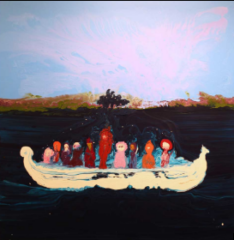 The Halloween of today looks much different from its origin, an ancient pagan festival celebrating the harvest and marking the end of summer. As the holiday became “American-ized” in the 1920s, it was actually a holiday for adults! According to Halloween collectibles expert, Mark B Ledenbach, Halloween “parties were all the rage then, but these were not for children. They were adult-oriented, with guests settling in to play Mahjong, bridge, and games. Tables and walls would be gaily decorated with a wide array of Halloween-themed items, setting the party’s mood. The games’ winners would be given prizes to take home, like candy containers, nodders, lanterns or noisemakers.”
The Halloween of today looks much different from its origin, an ancient pagan festival celebrating the harvest and marking the end of summer. As the holiday became “American-ized” in the 1920s, it was actually a holiday for adults! According to Halloween collectibles expert, Mark B Ledenbach, Halloween “parties were all the rage then, but these were not for children. They were adult-oriented, with guests settling in to play Mahjong, bridge, and games. Tables and walls would be gaily decorated with a wide array of Halloween-themed items, setting the party’s mood. The games’ winners would be given prizes to take home, like candy containers, nodders, lanterns or noisemakers.”
This is the era of decor where we find the greatest value in old Halloween decorations!
A glance through any Halloween collectibles book illustrates a vast array of those early 1910s – about 1950s Halloween decorations for adult parties:
- Games (ring toss, drawing while blindfolded, “dare”-type stunts, silly questions,
 tongue twisters)
tongue twisters) - Party decorations, usually made of paper or cardboard (invitations and envelopes, name placements, center-pieces, masks, headbands, nodders, aka “bobbleheads”)
- Lanterns (for tabletops)
- Noisemakers (similar to New Year’s Eve ones: clappers, tambourines, horns)
 According to Ledenbach, having familiarity with Halloween imagery “types” will be very helpful when trying to figure out its rarity. His ranking system follows as:
According to Ledenbach, having familiarity with Halloween imagery “types” will be very helpful when trying to figure out its rarity. His ranking system follows as:
-
-
- Devils (rarest)
-
- Ghosts, bats, veggie people (less common)
- Black cats, witches, skeletons, and owls (more common)
- pumpkins and Jack-o-lanterns (most common)
Ledenbach also advises that this category of collectibles has lasting appeal and potential value because (1) holidays are an annual occasion, and so they have continual (cyclical) interest, and (b) compared with Christmas decorations, which were saved as traditional seasonal heirlooms, these early Halloween decorations were usually thrown away after the party, which makes finding them a real treat!
-Michelle Miller






